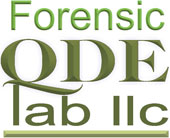When you think of the forensic world, what is the first thing that comes to your mind (after CSI, of course)?
Well, chances are you think of the past. After all, forensic specialists gather and examine information about the past. More importantly, perhaps, it is the study of how much someone leaves behind, floating in the ether of time – the fingerprints we can’t see or the handwriting impressions on a blank piece of paper. Every man, woman and child leave their “mark” behind – a mark that is changing with time.
Over the past fifty years, the forensic world has grown in leaps and bounds, due to major discoveries in science like DNA, or new technology that helps us analyze evidence like fingerprints and trace evidence. The future of the forensic world is subject to our imagination; and, for some, the online world is where the imagination leads. Have you noticed the word, ‘cyber’ is already being attached to a number of criminal activities? Do we really know what that means exactly?
Despite crimes being committed in digital space and crossing over wires and fiber optics, signatures are still being signed – marks are being left behind in some form. The forensic world is constantly evolving, yet the requirements of a forensic expert remain the same; use whatever proven protocol is available in a scientific and objective manner to identify the perpetrator of wrong-doing.
Take, for instance, online chat. Just as fingerprints are distinct to each person you meet, so are online chat habits. People use different phrases and words and change the way they write when they are chatting online, and those changes actually give us great insight into who is the person. In this category is where the Forensic Linguistics Expert shines. Handwriting identification is similar in that the physical movement of the writer is habitual and the combination of movements can be distinctly identifiable.
This type of online “cyber” forensics has scientists noting whether or not the words are spelled out or shortened, how emoticons are used and also logging word usage as a whole. This may not seem like much to go on, but, similar to forensic handwriting analysis, it’s the accumulation of little details that matter most.
The digital age is upon us. Now we see less and less young adults who are capable of cursive writing, which is the style that is most often used to identify a writer. There is a strong influx of hand printing used among younger writers and men. It is incumbent on the forensic document scientific community to confirm that the same methods used for cursive, also apply to hand printing. A study is currently under way to do just that. Meanwhile, other forensic specialists are performing studies to see if it is possible to determine identity traits with texts and instant message chat.
Case in point is a recent court case brought by the prosecutor who engaged a “cyber” expert to opine as to the identity of a sex offender by his online chat habits. While cases like this will likely come under close scrutiny for their acceptability in court, the practice will likely lead to more study into the forensic application of online text or chat log analysis.
In short, all of us leave our marks on the world – that much is certain; what marks they are and how they can be analyzed is the future of forensics. What do you think?
Source: http://motherboard.vice.com/read/the-budding-science-of-chatroom-forensics
